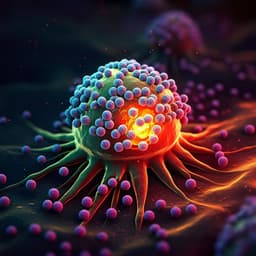
Engineering and Technology
Magnetic Hybrid Nanostructures for Cancer Theranostics: A Comprehensive Review
B. Govindan, M. A. Sabri, et al.
Explore the groundbreaking research by B Govindan, M A Sabri, A Hai, F Banat, and M A A Haija, delving into magnetic hybrid nanostructures (MHNs) revolutionizing cancer theranostics. From diagnosis to therapy, discover how these innovative structures are at the forefront of magnetic resonance imaging, drug delivery, and the integration of AI to enhance treatment outcomes.
~3 min • Beginner • English
Introduction
The paper frames cancer as a leading cause of mortality and surveys limitations of conventional therapies (surgery, chemotherapy, radiotherapy). It motivates magnetic hybrid nanostructures (MHNs)—composites combining magnetic components with polymers, carbons, noble metals, semiconducting fluorophores, or biomolecules—as promising platforms to improve cancer diagnosis and therapy. MHNs can enhance drug solubility and stability, enable targeted delivery using external magnetic fields, provide imaging contrast (MRI/optical), and support thermo-based therapies (hyperthermia, photothermal). The work also emphasizes integrating artificial intelligence (AI) to optimize design, synthesis, and deployment of MHNs in precision oncology.
Literature Review
The review comprehensively covers major classes of MHNs and their cancer-related applications:
- Polymer–magnetic hybrids: liposomes, polymeric micelles, and polymer-coated magnetic nanoparticles using biocompatible, biodegradable matrices (e.g., PLA, PGA, PLGA, PEG). Examples include temperature-responsive magnetite/polymer systems for drug delivery; PEG/PLGA micelles loading magnetite for hydrophobic drugs; DOX-loaded PLA-PEG-FA-SPIONs enabling chemo-hyperthermia; multifunctional PLGA/SPION systems for pancreatic cancer and glioblastoma.
- Carbon–magnetic hybrids: graphene, carbon nanotubes, carbon dots integrated with magnetic cores (FeCo, Fe3O4, γ-Fe2O3) for dual-modal imaging (MRI/fluorescence or photoacoustic), drug delivery, and hyperthermia. Studies demonstrate magnetothermodynamic therapy and improved antitumor efficacy via ROS-mediated immune effects.
- Noble-metal-based magnetic hybrids: Au, Ag, Pd integrated with magnetic components, exploiting plasmonic photothermal conversion, SERS, and fluorescence enhancement for therapy and imaging. Gold nanorod/graphene-DOX hybrids for PTT/chemotherapy, peptide-directed Ag nanocages for photothermal therapy, and 64Cu-integrated Au nanorods for PET-guided PTT are highlighted.
- Semiconducting fluorescent nanomaterial–magnetic hybrids: quantum dots (CdTe/ZnS, CdSe@CdS, CdTeS), CuFeSe2, carbon/graphene quantum dots coupled with magnetic cores for multimodal MRI/fluorescence imaging and PDT/PTT.
- Biomolecule-conjugated MHNs: DNA/RNA/protein/peptide-functionalized magnetic nanostructures for targeted delivery, imaging, biosensing (e.g., FA-modified magnetic RNA nanoflowers; PEGylated Fe3O4 bearing gemcitabine and pHLIP for pancreatic cancer). The review also spans diagnostic systems: MRI (T1/T2 agents), magnetic fluorescent probes, magnetic biochips (microfluidic exosome/CTC capture), and magnetic biosensors (GMR, electrochemical) using ferrites and noble-metal composites.
- Therapeutic modalities: chemotherapy delivery (passive/active targeting), stimuli-responsive release (pH, temperature, ultrasound), magnetic hyperthermia, photothermal and photodynamic therapy, and emerging magnetic nanorobots.
- AI integration: applications in MRI image analysis, device planning for hyperthermia (ANN, PSO optimization), nanoparticle synthesis/design optimization, toxicity prediction, microfluidic data analysis, and liquid biopsy analytics.
Methodology
Key Findings
- MRI contrast design principles:
- Particle size strongly dictates MRI modality: MHNs >10 nm generally serve as T2 agents; sub-5 nm ultra-small SPIOs (uSPIO/uIONP) act as T1 agents with ~15% T1/T2 enhancement at 0.5–1 h post-injection in mice and improved brain tumor visualization across the BBB.
- Fe3O4@Au-PEG-EpCAM enabled dual OAT–MRI detection of HepG2 tumors with OAT peak at ~3 h and T2 signal enhancement; smaller PEGylated Cu0.08Zn0.54Fe2.38O4 (<5 nm) showed long-term colloidal stability and T2 thermometry correlation.
- Magnetic fluorescent imaging probes: Lipid-encapsulated Fe3O4 with dialkylcarbocyanine dyes and targeting ligands provided high-contrast MRI/fluorescence in vivo; CuFeSe2 nanocrystals delivered NIR absorbance (500–1100 nm) for CT-guided PTT; carbon-decorated ferrite nanodots enabled T1/T2 MRI and fluorescence with low toxicity and stimulus-responsive drug release.
- Biochips and biosensors:
- Microfluidic Raman chip detected prostate cancer exosomes within 1 hour; exosomes higher in patient serum than healthy controls.
- GMR biosensors quantified ovarian cancer biomarkers CA125 II, HE4, IL6 with LODs <3.7 U/mL and ~7.4 pg/mL; ferrite-based electrochemical sensors detected CA125 and CEA with high sensitivity; NiFe2O4-, CoFe2O4-, ZnFe2O4-based platforms enhanced signal and selectivity.
- Chemotherapy delivery:
- FA@HPG@Fe3O4 loaded curcumin (max loading 82–88%), improved cellular uptake, and enhanced T2 MRI in HeLa cells.
- Dual-drug magnetic hydrogels (DOX+docetaxel) achieved AMF-triggered asynchronous release and superior antitumor efficacy to single-drug hydrogels in TNBC models.
- Combination chemo/MF/PTT therapies reduced metastatic activity (e.g., via CXCL12/CXCR7 expression modulation).
- Stimuli-responsive delivery:
- Ultrasound-triggered systems (Fe3O4–SiO2 nanodroplets, microbubble conjugates) enhanced DOX delivery and cancer cell killing in pancreatic models.
- pH-triggered systems (PMMA-hydrazone magnetic nanocubes; chitosan/folic-acid–labeled mesoporous magnetic NPs; AMNCs; MOF-based hybrids) released drugs preferentially at pH ~5, targeting tumor microenvironments.
- Magnetic hyperthermia:
- Gd-doped Mn–Zn ferrites in vitro deactivated up to 61% A549 cells within 1 h MFH.
- In vivo hyperthermia with oleic-acid–stabilized iron oxide NPs improved survival in Walker 256 carcinoma (6/7 treated vs none in control).
- ANN and hybrid ANN–PSO accurately predicted localized temperatures (42–47°C), optimizing particle concentration, AMF, exposure time; ANN identified optimal graphene–Fe3O4 compositions for SAR.
- PTT/PDT:
- Magnetic nanocomposite plus dual PDT+PTT achieved ~94% maximum tumor volume reduction vs other regimens in a breast cancer in vivo study; multiple Au/Ag/Pd-based hybrids demonstrated strong photothermal effects.
- Magnetic nanorobots:
- Demonstrated in vitro targeted delivery of DOX and cisplatin, reduced cancer cell viability, and in vivo improved outcomes in mouse models; multifunctional systems achieved >84.5% Hep3b cell kill in 24 h in vitro and >63.7% in vivo via combined chemo-PTT, with concurrent MRI contrast.
- General principle: Surface functionalization (PEG, FA, antibodies/peptides), ultra-small sizes for T1, and biocompatible shells (silica, polymers, carbon) improve stability, targeting, and multimodality.
Discussion
The synthesis of diverse MHNs enables complementary mechanisms—magnetic guidance/retention, imaging contrast (T1/T2 MRI, OAT, fluorescence), and controlled therapy (drug release, hyperthermia, PTT/PDT). Evidence shows that size-engineered iron oxide and alloyed ferrites can be tuned for specific MRI roles and hyperthermia efficacy, while hybridizing with polymers, carbon, or noble metals yields multifunctional theranostics. Diagnostic performance advances include rapid exosome detection, multiplexed protein biomarker biosensing with low LODs, and high-contrast multimodal imaging of tumors. Therapeutically, MHNs enable higher loading of hydrophobic drugs, targeted accumulation, and stimulus-responsive release, improving antitumor effects and reducing systemic toxicity. AI augments these systems by optimizing nanoparticle design, treatment parameters, and imaging analytics, supporting precision medicine. Collectively, the findings support MHNs as a convergent platform to address limitations in specificity, monitoring, and efficacy in oncology.
Conclusion
The paper concludes that multifunctional MHNs are poised to transform cancer diagnosis and therapy by integrating targeting, imaging, and treatment in a single platform. Key translational design rules include: tailoring particle size and surface chemistry for desired MRI modality (T1 vs T2), ensuring biocompatible, stable coatings for circulation and targeting, and adopting polymer/carbon/noble metal hybrids to enable multimodal imaging and controlled therapy (hyperthermia, PTT/PDT, stimuli-responsive release). Magnetic microchips and GMR/electrochemical biosensors offer sensitive, low-cost diagnostics but need engineering for clinical translation. Future directions emphasize: scalable, reproducible syntheses with tight size distributions; long-term safety and biodistribution studies; robust, cost-effective manufacturing; and systematic AI integration for nanoparticle optimization, treatment planning, and real-time response monitoring.
Limitations
Key limitations include potential toxicity of magnetic nanomaterials driven by particle size, dose, solubility, biodegradability, and surface chemistry. MNPs may disrupt cell viability, generate ROS/free radicals in acidic tumor microenvironments, and cross physiological barriers, raising safety concerns. Certain ferrites (e.g., Co- or Ni-ferrites) exhibit higher toxicity than iron oxides, despite favorable magnetic properties. Long-term in vivo toxicity, biodegradation, and environmental impacts remain insufficiently characterized. Translation challenges span stability, reproducibility, large-scale synthesis, and regulatory acceptance. Mitigation strategies include polymer/carbon/silica/noble-metal coatings to enhance biocompatibility, biomolecule conjugation for specificity, and AI tools for dose/toxicity optimization. Real-time clinical validation of biosensors and theranostic systems is still lacking.
Related Publications
Explore these studies to deepen your understanding of the subject.







